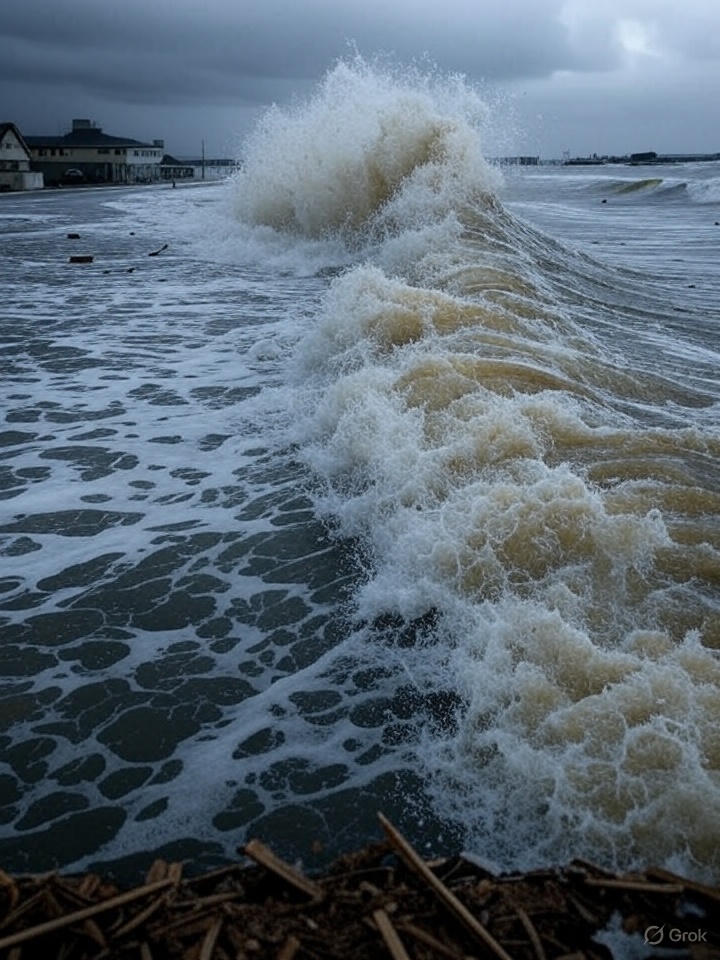On July 30, 2025, a colossal magnitude 8.8 earthquake struck off Russia’s Kamchatka Peninsula, triggering tsunami waves that travelled thousands of miles and reached the shores of the United States, including Hawaii, Alaska, and the West Coast. The event was rated among the six strongest earthquakes ever recorded.
The Earthquake: Epicenter, Strength & Tectonic Context
- The quake occurred approximately 119, 136 km east to southeast of Petropavlovsk Kamchatsky, at a shallow depth between 19.3, 20.7 km, exacerbating its tsunami generating potential (Reuters).
- It ranks among the strongest globally in recent decades equivalent in scale to the devastating 9.0 event that hit Japan in 2011 (Globedge, Reuters).
- The earthquake struck along the active Kurile Kamchatka subduction zone, where the Pacific Plate plunges beneath the Okhotsk Sea Plate, historically producing megathrust earthquakes and destructive tsunamis (Wikipedia).
Russia & Japan: Ground Zero and Immediate Impact
- Tsunami waves up to 5 metres (16 ft) slammed into Severo Kurilsk on the Kuril Islands, flooding the port and submerging parts of the town. Emergency services evacuated around 2,000 residents, with a state of emergency declared in the region (Reuters).
- In Kamchatka proper, waves measured 3,4 m; nearby towns, including Severo Kurilsk, experienced major flooding and structural damage, such as a destroyed kindergarten (Reuters, Al Jazeera, AP News).
- In Japan, waves up to 60 cm (2 ft) reached coastal areas such as Hokkaido, prompting evacuations and disruption around nuclear facilities, including Fukushima (AP News, Reuters, AP News). In Mie prefecture, a woman died in a car crash fleeing the evacuation (Reuters).
U.S. Impact: Hawaii, Alaska & the West Coast
- The Pacific Tsunami Warning Center alerted residents in Hawaii, where waves peaked at approximately 1.7 m (5.5 ft). Evacuation orders were issued statewide, ships were ordered out of ports, and travel disruptions occurred especially in Honolulu and Maui, where the airport closed temporarily (Reuters).
- Smaller tsunami waves nearly 0.5 m were detected along California, Oregon, Washington, and British Columbia, leading to coastal advisories and warnings against entering harbors or beaches (KSBW).
- In Alaska, particularly the Aleutian Islands, readings approached around 1.4 ft, with advisory levels urging caution along remote shorelines (AP News).
- Officials warned the impact could last for hours or over a full day, as tsunamis typically unfold in multiple waves and strong currents persisting long after the initial surge (AP News).

What Made This Event So Dangerous
- The quake’s intensity and shallowness, combined with its release along a tectonic plate boundary, greatly amplified its tsunami potential even at great distance (The Washington Post, Reuters).
- Compared with earlier megathrust events in this region such as the 1952 magnitude 9.0 Severo Kurilsk quake generating 18 metre tsunamis this event was slightly smaller but still extremely powerful (Wikipedia).
- Experts stress that such enormous events happen only once per decade or so around the Pacific, making each one a serious global terror hazard (The Washington Post, Wikipedia).
Response & Preparedness: Lessons & Takeaways
- Emergency preparedness was swift across the region: in Hawaii, California, Alaska, and Japan, authorities activated evacuation plans and public alert systems promptly(Globedge).
- A dramatic field hospital footage from Petropavlovsk-Kamchatsky showed surgeons continuing operations while tremors rattled the operating room a testament to resilience under pressure (Reuters).
- Public memory of previous catastrophes especially Japan’s 2011 tsunami helped spur compliance with evacuation orders and public caution in the affected regions (AP News, The Washington Post).
Summary
A rare and devastating magnitude 8.8 earthquake off Russia’s Far East on July 30, 2025, generated tsunami waves reaching up to 5 metres in Russia and causing measurable waves across the Pacific Rim, including Hawaii and the U.S. West Coast. Though severe destruction was largely avoided outside Russia and Japan, more than a dozen countries issued warnings and evacuations. The event underscores the importance of early warning systems, international alert coordination, and public readiness for seismic disasters, even when the epicenter is thousands of kilometres away.

